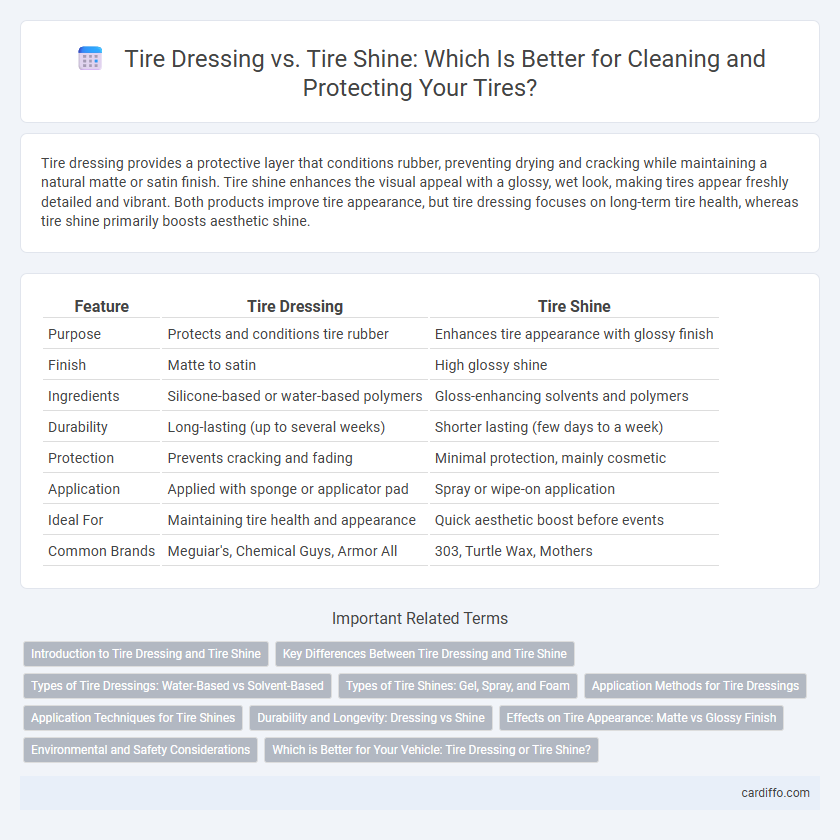Tire dressing provides a protective layer that conditions rubber, preventing drying and cracking while maintaining a natural matte or satin finish. Tire shine enhances the visual appeal with a glossy, wet look, making tires appear freshly detailed and vibrant. Both products improve tire appearance, but tire dressing focuses on long-term tire health, whereas tire shine primarily boosts aesthetic shine.
Table of Comparison
| Feature | Tire Dressing | Tire Shine |
|---|---|---|
| Purpose | Protects and conditions tire rubber | Enhances tire appearance with glossy finish |
| Finish | Matte to satin | High glossy shine |
| Ingredients | Silicone-based or water-based polymers | Gloss-enhancing solvents and polymers |
| Durability | Long-lasting (up to several weeks) | Shorter lasting (few days to a week) |
| Protection | Prevents cracking and fading | Minimal protection, mainly cosmetic |
| Application | Applied with sponge or applicator pad | Spray or wipe-on application |
| Ideal For | Maintaining tire health and appearance | Quick aesthetic boost before events |
| Common Brands | Meguiar's, Chemical Guys, Armor All | 303, Turtle Wax, Mothers |
Introduction to Tire Dressing and Tire Shine
Tire dressing and tire shine are essential products in automotive care designed to enhance the appearance and protection of tires. Tire dressing typically contains conditioning agents that penetrate rubber, preventing cracking and fading, while tire shine primarily focuses on providing a glossy finish. Both products contribute to maintaining tire durability and aesthetics, but tire dressing offers longer-lasting protection against environmental elements.
Key Differences Between Tire Dressing and Tire Shine
Tire dressing primarily focuses on conditioning and protecting rubber, using silicone or water-based formulas that prevent cracking and fading, while tire shine is designed chiefly for enhancing the visual gloss and wet look of tires. Tire dressings typically offer longer-lasting protection against UV rays and dirt accumulation, whereas tire shines provide an immediate but often shorter-lived aesthetic boost. Understanding these differences helps in choosing the right product for either long-term tire maintenance or temporary cosmetic enhancement.
Types of Tire Dressings: Water-Based vs Solvent-Based
Water-based tire dressings offer a non-toxic, eco-friendly option that provides a natural matte or satin finish, enhancing tire appearance without greasy residue or strong odors. Solvent-based dressings deliver a high-gloss shine with long-lasting protection against cracking and fading, making them ideal for heavy-duty or show-quality tires. Choosing between water-based and solvent-based formulations depends on the desired finish, environmental considerations, and the level of protection required for tire maintenance.
Types of Tire Shines: Gel, Spray, and Foam
Tire shines come in three main types: gel, spray, and foam, each offering unique benefits for tire maintenance. Gel tire shines provide long-lasting, thick coverage that resists runoff and is ideal for achieving a deep, glossy finish. Spray formulas deliver quick, even application and light shine, while foam tire shines offer easy application with a clean, non-greasy look, making them popular for restoring tire appearance without buildup.
Application Methods for Tire Dressings
Tire dressings are typically applied using a sponge, applicator pad, or spray bottle to ensure even coverage and prevent sling onto the tire sidewalls. A clean, dry tire surface is essential before application to maximize adhesion and longevity of the product. For best results, multiple thin layers of tire dressing should be applied and allowed to dry between coats, enhancing the tire's appearance and protection against cracking and fading.
Application Techniques for Tire Shines
Tire shine products require careful application techniques to ensure even coverage and a long-lasting glossy finish. Using a foam applicator or a microfiber cloth, apply the tire shine in thin, uniform layers to prevent drips and streaks on the tire surface. Allow each layer to dry completely before applying subsequent coats for optimal protection and enhanced tire appearance.
Durability and Longevity: Dressing vs Shine
Tire dressing offers superior durability and longevity compared to tire shine, as it is formulated with advanced polymers that create a resilient, long-lasting protective layer on the tire surface. Unlike tire shine, which primarily provides a glossy finish that fades quickly under UV exposure and road conditions, tire dressing maintains tire flexibility and resists cracking, extending the life of the product's aesthetic and protective qualities. Professional-grade tire dressings can protect tires for weeks, minimizing the need for frequent applications and enhancing overall maintenance efficiency.
Effects on Tire Appearance: Matte vs Glossy Finish
Tire dressing typically provides a matte finish that enhances the tire's natural texture while preventing a slick or overly shiny look. In contrast, tire shine products deliver a glossy finish that makes tires appear wet and highly polished, amplifying visual appeal especially for show cars. Choosing between a matte or glossy finish depends on the desired aesthetic effect and tire maintenance preferences.
Environmental and Safety Considerations
Tire dressing typically consists of water-based or solvent-based formulas that offer durable protection but may contain volatile organic compounds (VOCs) impacting air quality. Tire shine products often prioritize aesthetic appeal with silicone oils and polymers, yet these chemicals can increase tire surface slipperiness, posing safety risks on wet roads. Environmentally conscious options favor biodegradable ingredients with low toxicity, reducing harmful runoff and promoting safer driving conditions.
Which is Better for Your Vehicle: Tire Dressing or Tire Shine?
Tire dressing and tire shine both enhance a vehicle's appearance, but tire dressing is better for long-lasting protection and maintaining tire health, as it penetrates the rubber to prevent cracking and fading. Tire shine primarily offers a glossy, wet look but may wear off quickly and sometimes use silicone-based formulas that can degrade the tire over time. For optimal tire care and durability, choosing tire dressing with UV protection and without harmful solvents is the preferred option.
Tire Dressing vs Tire Shine Infographic

 cardiffo.com
cardiffo.com